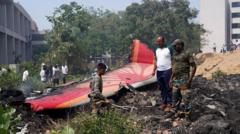How Did India Recover Data from the Crashed Air India Flight Recorders?

Understanding the Recent Air India Crash and the Role of Flight Data Recorders
The tragic crash of Air India Flight 171 has sent shockwaves through both the aviation community and the public. With at least 270 lives lost, this incident marks one of the most catastrophic air disasters in recent Indian history. In light of this, investigators have made significant progress in the ongoing investigation, having recovered crucial flight recorder data, often referred to as "black boxes." This article explores the details of the crash, the recovery of flight data, and what this means for aviation safety in the future.
The Incident: Timeline and Key Facts
On June 12, 2023, the London-bound Boeing 787-8 Dreamliner took off from Ahmedabad airport, only to crash less than a minute later into a densely populated neighborhood. Here are some key facts about the incident:
- Flight Details: Air India Flight 171 was scheduled to fly from Ahmedabad to London.
- Flight Duration: The aircraft was airborne for less than 40 seconds before the crash.
- Casualties: Of the 242 passengers on board, only one survived.
- Pilot Information: The plane was piloted by Captain Sumeet Sabharwal and co-pilot Clive Kundar.
- Last Communication: The aircraft issued a mayday call shortly after takeoff, marking its final transmission.
The Recovery of Flight Recorders
One of the pivotal steps in understanding what led to this tragic event is the recovery of the flight recorders. The Enhanced Airborne Flight Recorders (EAFRs) from the Boeing 787 were successfully retrieved on June 13 and June 16, marking a significant milestone in the investigation. The recorders consist of two key components:
1. Flight Data Recorder (FDR)
The FDR is crucial for capturing various parameters that can help investigators piece together the final moments of the flight. This device records:
- Aircraft position
- Gear and flap lever positions
- Thrust settings
- Engine performance
- Fuel flow data
- Fire handle activation
2. Cockpit Voice Recorder (CVR)
The CVR is essential for capturing the audio environment of the cockpit. This includes:
- Pilot radio communications
- Individual microphone audio
- Ambient sounds within the cockpit
By analyzing the data from these recorders, investigators can reconstruct the sequence of events leading up to the crash and identify potential contributing factors.
Investigative Process and Collaboration
The Indian Aircraft Accident Investigation Bureau (AAIB), in collaboration with the US National Transportation Safety Board (NTSB), is conducting a thorough analysis of the recovered data. The aviation ministry has stated that the analysis is currently underway, and they aim to release findings to the public in a timely manner. NTSB chair Jennifer Homendy has emphasized the importance of transparency in the investigation for public safety and awareness.
Challenges and Concerns
Despite the significant progress in the investigation, there are concerns regarding the timeline for analyzing and releasing the data. The recovery and analysis of flight recorder data can take several weeks, and aviation experts have noted the delay as unusual. Some of the challenges faced by investigators include:
- Technical complexities in data recovery and analysis
- Cooperation between multiple international agencies
- Ensuring accuracy and reliability in the findings
The Importance of Flight Data Analysis in Aviation Safety
Flight data analysis is a critical component in improving aviation safety. By understanding the causes of crashes, regulatory bodies can implement measures to prevent future incidents. Some key benefits of thorough flight data analysis include:
- Risk Identification: Understanding patterns and risk factors associated with aviation accidents can lead to better training and safety protocols.
- Regulatory Improvements: Findings from investigations often lead to updated regulations and standards that enhance overall aviation safety.
- Public Awareness: Transparency in investigations can help build public trust in the aviation industry.
Conclusion: The Path Forward for Aviation Safety
The recovery of flight recorder data from the Air India crash is a crucial step in understanding the tragic events that unfolded on June 12, 2023. While the investigation is still ongoing, the analysis of this data will be instrumental in identifying the factors that contributed to the incident. As investigators work diligently to uncover the truth, the aviation industry must remain committed to learning from such disasters to enhance safety measures and prevent future occurrences.
As we await the findings of this investigation, one must consider the broader implications of aviation safety. What measures can be taken to ensure that such tragedies are minimized in the future? The ongoing dialogue around aviation safety is more important than ever.
FAQs
What are the Enhanced Airborne Flight Recorders (EAFRs)?
The Enhanced Airborne Flight Recorders are devices that capture critical flight data and cockpit audio to assist in accident investigations. They consist of a Flight Data Recorder (FDR) and a Cockpit Voice Recorder (CVR).
How long does it take to analyze flight data after a crash?
The analysis of flight data can take several weeks, depending on the complexity of the data and the cooperation of various investigative agencies.
Why is transparency important in aviation safety investigations?
Transparency in aviation safety investigations helps build public trust and ensures that findings are used to improve safety measures, preventing future incidents.
As the investigation progresses, what do you think are the key areas that need improvement in aviation safety protocols? #AviationSafety #AirIndia #FlightInvestigation
Published: 2025-06-27 07:29:23 | Category: technology



